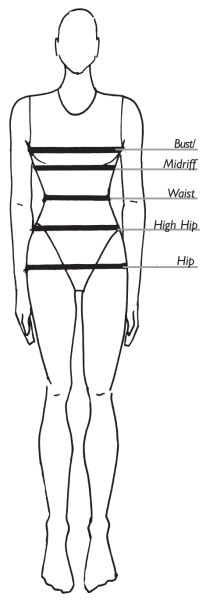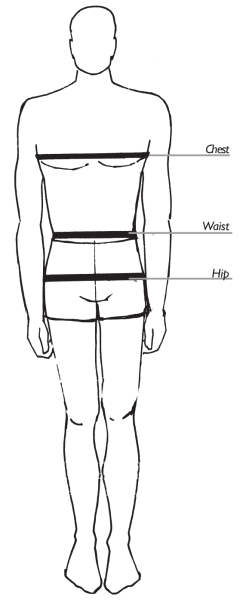
2.1

2.2
Once you know the key body landmarks, you can use those and other body points to measure all of the body dimensions appropriate for your market.The following defines and illustrates all of the measurements used within the Standard Body Measurements Section of this handbook.
To accurately measure body dimensions, the figure should be undressed and in underwear, there should be no padding or shaping in any of the undergarments. Shoes should be off and your model, unless a newborn or infant, should be standing straight for all measurements and breathing normally.When measuring a newborn or infant, then the baby should be laying flat.
Use a tape measure for taking all body dimensions, except heights. Keep your tape measure flat against the body, it should not hang loosely nor should it constrict the body along any point. Use a measuring stick for taking height and other dimensions from the floor.There are two measurements that are exceptions.They are the Neck and the Armhole dimensions. These are small circumferences and a tape measure cannot get the exact curve for an accurate measurement.They are best measured using a cord or thin chain. Place the cord or chain along the neck or armhole line and the cord or chain can be measured flat once it is removed from the body.
It is suggested when using the following or any measurements in communication with factories, patternmakers and others that you advise them how you are measuring, so they do the same.
Body dimension measurements are illustrated in Sketches 2.1 through 2.22 and explained in the following:
1. Bust/Chest: The circumference along the horizontal line at the fullest point of the bust or chest, your tape measure should go over the shoulder blades, under the arms and across the bust points. (Sketch 2.1 and 2.2)
2. Midriff: The circumference around the top of the diaphragm, just under the bust. (Sketch 2.1)
3.Waist: The circumference along the horizontal line that is the natural waistline, at the narrowest point around the torso, below the bottom rib and above the hip bones. (Sketch 2.1 and 2.2)
4. High Hip: The circumference around the upper part of the hips and across the fullest part of the abdominal area.Typically, on the female figure, this line falls 4” below the waist. (Sketch 2.1)
5. Hip: The circumference along the horizontal line at the widest point of the hips, across the fullest part of the buttocks and over the upper end of the thigh bone.This measurement is also referred to as the “Seat”. (Sketch 2.1 and 2.2)
Illustrated and Written by Andrea Kennedy of Fashiondex.com
